| Text: The Field Trip | Images: Fossil Plants | Images: On-Site |
| List: Fossil Species | Links: Other Plant Sites | Widget: Fallon Weather |
| Links: My Music Pages | Links: My Fossils Pages | E-Mail Address |
|
In the Dead Camel Range near Fallon, Churchill County, Nevada, paleobotany enthusiasts have had, for decades, an enjoyable and educational experience fossil-prospecting for 12.6-million-year-old plant remains in a sedimentary rock deposit geologists call the Middle Miocene Desert Peak Formation. The popular paleontologically significant site lies at an elevation of 3,900 feet on the slopes of an unnamed dry wash whose erosive power through the ages has exposed a series of fossiliferous siliceous shales, occasionally interbedded with intrusive volcanic basalt and basaltic tuffs. Despite the fact that the sedimentary sequence has been invaded through time by such disruptive volcanic activity, the oldest shale accumulations in the Desert Peak Formation, or those beds exposed lowest in the local stratigraphic section, have continued to provide both amateur plant seekers and professional paleobotanists alike with an abundance of nicely preserved leaves from a variety of deciduous trees and evergreen live oaks, in addition to samaras (winged seeds), needles and twigs from several types of conifers. In all, paleobotanists have identified some 22 species of ancient plants from the Middle Miocene Desert Peak Formation. The flora list includes such varieties as evergreen canyon live oak, European aspen, paper birch, Utah juniper, white fir and Giant Sequoia--all of which contrast dramatically with the desert extremes of the Fallon district today. The fossils provide incontrovertible evidence that 12.6 million years ago an extensive oak-juniper woodland thrived near the lower reaches of a mixed conifer forest in a region subjected to intermittent volcanic activity. The famous fossil plant locality frequented by paleobotany enthusiasts in the Dead Camel Range has remained open to hobby inspection for many decades now; when last field checked, the Miocene plants still occurred on Public Lands administered by the Bureau of Land Management (a significant portion of the Dead Camel Range does happen to lie within the boundaries of the Fallon Naval Air Station). This means that visitors were able to collect, for personal use only, a wonderful selection of Middle Miocene fossil plants, specimens that must never be bartered or sold. Then too, collectors had to be careful not to abuse their privileges here. The operative attitude one had to bear in mind was that the noted Dead Camel Range fossil plant site remained open to the public only because the local landowners, across whose property visitors needed to pass in order to reach the region, recognized the great recreational value of their vast desert surroundings. They encouraged visitors to experience the rewards of back-country explorations amidst the challenging austerity of the Great Basin Desert while continuing to maintain a stern vigilance over the natural domain. Had a clear pattern of disregard for property emerged, rest assured that the paleobotanical treasures in the Dead Camel Range would not only have become off limits to all amateur fossil collectors, but also to every visiting desert enthusiast, in general. The Dead Camel Range flora occurs in the basal portion of the Middle Miocene Desert Peak Formation--a geologic rock unit dated by radiometric methods at 12.6 million years old. It consists of around 500 feet of thick-bedded siliceous shale (in beds one to five inches thick, on average) that weathers to shades of yellowish-brown, brownish-red and maroon. Unweathered beds of the fossiliferous fine-grained shales often reveal a pale olive-green coloration. The shale frequently disintegrates through erosion to form rubble-strewn slopes, a characteristic style of weathering which masks the true lithologic nature of the underlying strata. Interbedded with the sedimentary rocks are a few minor volcanic contaminants--basalt flows and basaltic tuff--which have locally metamorphosed the shales, sometimes obliterating any fossil material they might have originally contained. Though this is not always the case. Some of the better-preserved fossil plant remains actually occur in highly altered shales, demonstrating here at least that fossil plants can often withstand a great degree of geologic stress and survive to tell their fascinating paleobotanical tales. The fossil-bearing shales are clearly of lacustrine origin (deposited in a lake), and the plants that were preserved in them most likely accumulated near the shoreline. There is little evidence to support the idea that currents carried the ancient plant specimens far from the margin of the lake into which they were swept by repeated storm waters over the course of tens of thousands of years, at the very least. If they had truly been preserved through the action of lake currents, the plant material would certainly be found as scattered, rare remains throughout the sedimentary deposit, not as a complete fossil flora concentrated within a relatively narrow shale horizon. At the primary fossil locality situated along the unnamed dry wash in the Dead Camel Range, the fossil plants are fairly common. They are typically preserved as pale brown to dark reddish-brown impressions that stand out in bold contrast on a paler-colored matrix of yellowish-brown to pale olive-green shale. But, as the sedimentary deposits are traced away from that principal accumulation of Middle Miocene plants, collectors learned that the once-productive shale rapidly turns barren of organic remains: all fossils simply disappear due to the mysterious nature of sedimentary deposition some 12.6 million years ago. The fossil locality apparently corresponds to a favorable position along the bottom of the ancient Middle Miocene lake, where plant debris--transported/swept into the waters from the surrounding countryside--was buried rapidly by tons upon tons of inflowing mud and silt: organic tissues were obviously covered completely before any significant decay could begin. To locate the best-preserved fossil plants in the Dead Camel Range, the highly indurated siliceous mud within which they lie hidden had to be successfully split, revealing the Middle Miocene treasures to their first light of day in some 12.6 million years. This certainly involved a lot of paleontological dedication and patience, not to mention hard work, but the ultimate reward of many perfect, complete evergreen live oak leaves and an occasional conifer samara, among other botanic types, created a burning anticipation for an encounter with the distant geologic past. The basic idea was to first remove large chunks of potential leaf-yielding shale from the Desert Peak Formation exposures, then, using a good quality geology hammer (the steel must be tempered properly or the metal will spall off with shrapnel-like ferocity, potentially inflicting serious injuries), one proceeded to strike the shale chunks along their natural bedding planes, where the mud and silt had accumulated layer by layer to form sedimentary rock. If nothing significant popped out at you, another try with a different piece of shale could reasonably be expected to net an excellent specimen or two. The quality specimens were indeed present there, even if it took a measure of dedication to recover them. One needed to remember that this was an old and famous fossil locality--a favorite of rockhounding locals from the Fallon and Reno areas, in particular. The upshot was that after decades of intensive collecting by amateurs and professional paleobotanists alike, it was indeed remarkable that the Fallon site continued to yield such a reliable selection of fossil plant specimens. The history of collecting in the Dead Camel Range goes all the way back to the first half of the 1900s. In the summer of 1936, two amateur collectors from Fallon, Laura Mills and Ray Alcorn, brought fossil leaves from the Dead Camel Range to the attention of Ralph W. Chaney, one of the more renowned paleobotanists of the 20th century. After making a preliminary assessment of the find, Chaney handed the project over to Daniel I. Axelrod. Several weeks later Axelrod accompanied Mills and Alcorn to the discovery site, or what has since become known as the primary fossil locality along an unnamed dry wash in the Dead Camel Range. They collected a modest supply of fossil plants at that time--a large enough selection, at least, for Axelrod to determine that the area demanded a formal paleobotanical interpretation, preferably in a scientific monograph. Mills and Alcorn knew that they had discovered a productive fossil plant horizon. When they learned of the genuine scientific importance of it, they generously presented Axelrod with the extensive collection of fossils they had already taken from the locality, a collection that amounted to several hundred specimens according to Alcorn. Axelrod returned to the Fallon site several times over the succeeding years, accompanied either by his wife Nancy Robinson Axelrod or his long-time field companion, Robert E. Smith (who in addition to digging, helped maintain accurate records of the plant taxa recovered). In time, they had amassed an exhaustive collection of some 1,390 specimens from the Desert Peak Formation--enough fossil material to allow a definitive paleobotanical treatise on the subject. Axelrod eventually published his findings concerning the Dead Camel Range plants in a monumental scientific monograph in the 1950s. All told, Axelrod described 22 species of fossil plants from the Dead Camel locality. The most common specimens he encountered were fragmentary and complete leaves belonging to an evergreen live oak, called scientifically Quercus pollardiana. It is identical in every major delineating leaf characteristic to the living canyon live oak, or maul oak Quercus chrysolepis now native to California's mountainous regions: western slopes of the Sierra Nevada; Coast Ranges; San Gabriel Mountains, and Klamath Mountains. Maul oak also extends into western Nevada, southwestern Orgeon, southerwestern New Mexico, Arizona, and northern Mexico. Even though the oaks appear indistinguishable, most American paleobotanists give the Miocene variety a different scientific species name in order to emphasize the great distance in geologic time between the fossil and modern species of the same plant. European paleobotanists on the other hand prefer to retain the modern scientific names for fossil species which appear identical to those still living. After canyon live oak, in decreasing order of relative abundance the next eleven most common forms encountered in the Middle Miocene Desert Peak Formation were: interior live oak (Quercus wislinoides); an extinct water oak, related to the modern White Oak (Quercus simulata); the Brewer spruce (Picea sonomensis); Giant Sequoia (Sequoiadendron chaneyi); White Fir (Abies concoloides); Oregon grape (Mahonia reticulata); a Lemmons willow (Salix knowltoni); a second species of Mahonia, Leatherleaf Mahonia (Mahonia marginata); Pacific madrone (Arbutus matthesi); Arizona ash (Fraxinus alcorni), named after Ray Alcorn, who made many of the early collections from the Dead Camel locality; and Ponderosa pine (Pinus florissanti). The 10 rarest species found included a Black cottonwood (Populus eotremuloides); a sandbar willow (Salix payettensis); California nutmeg (Torreya nancyana); the paper birch (Betula thor); Curlleaf mountain-mahogany (Cercocarpus linearfolius); Utah juniper (Juniperus nevadensis); Japanese scholar tree (Sophora spokanensis); western redcedar--which is in reality a cypress (Thuja dimorpha); a European aspen (Populus subwashoensis); and the common cattail (Typha lesquereuxi). The Dead Camel paleobotanical remains record an oak-juniper woodland community near the lower reaches of a mixed-conifer forest, similar to modern plant associations that inhabit the western flanks of the southern Sierra Nevada in California. Paleobotanist Daniel I. Axelrod believed that the fossils accumulated in a rather regional, localized lake basin into which streams dumped detritus from a terrain dominated to the south by rhyolite cones of moderate elevations. That kind of ecological setting, he reasoned, permitted coniferous varieties usually restricted to the uplands to descend the cooler, moister north-facing slopes and enter the fossil record along with evergreen live oaks and species of deciduous trees and shrubs that preferred the lowlands. Plant varieties nearest the shoreline and along the bordering stream courses included Arizona ash, Black cottonwood, sandbar willow and water oak. Drier, sunnier sites at slightly higher elevations supported an extensive oak-juniper woodland dominated by canyon live oak, interior live oak, Utah juniper and Pacific madrone. And the nearby forest community included specimens of white fir, Brewer spruce, Ponderosa pine, canyon live oak and Giant Sequoia/Big Tree. Axelrod concluded that the Dead Camel Range flora received approimately 25 inches of rain per year. This is in glaring contrast to the scant six or seven inches delivered annually to the area today, almost all of it falling during the winter months. Yet, 12.6 million years ago there was certainly ample summer rainfall over the ancestral Fallon basin--at least enough to support such sensitive botanical indicators as paper birch, Oregon grape and Japanese scholar tree. Middle Miocene times were probably mild and comfortable, with a frost-free season ranging from seven to eight months; today, the frost-free season barely lasts four months, and the Fallon district experiences extended episodes of wicked winter chilling. That remarkable contrast in environments is on display in the rocks of the Dead Camel Range near Fallon, Nevada. Here, along a narrow dry gully in the middle of the Great Basin Desert (a land of brutal weather extremes and austerity of plant life) is direct proof of what once existed in this part of west-central Nevada some 12.6 million years ago: The lake-originated shale exposed by the powers of erosion contain the preserved evidence of an extensive oak-juniper woodland that intermingled with a rich mixed-conifer forest. It was a paleo-landscape in which canyon live oak thrived in proximity to white fir and western redcedar and Giant Sequoia. Today, the volcanic peaks of the Dead Camel Range rise above the fossil locality: rugged, barren outcroppings of solidified lava that postdate the accumulation of fossil plants in the Desert Peak Formation below. There are no trees atop the summits, neither can a single variety be found along their slopes--yet, the shadows they cast across the tortured desert landscape cross a place where old sediments hide an age of green. |
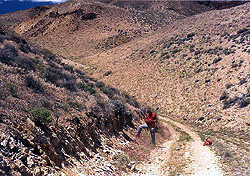 |
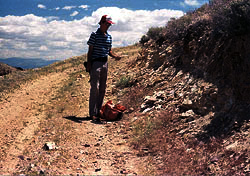 |
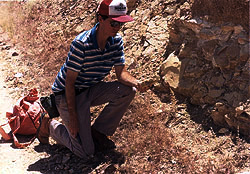 |
| Click on the images for larger pictures. At left is the view roughly due west into the heart of the Dead Camel Range near Fallon, Nevada, where a fossil seeker searches for 12.6 million-year-old plant remains in the Middle Miocene Desert Peak Formation. The middle image is a view looking back eastward from the primary fossil plant locality in the Dead Camel Range; here, a paleobotany enthusiast explores a fossiliferous exposure of the Desert Peak Formation, which yields 22 species of ancient plant remains, including the leaves of evergreen live oak, in addition to many deciduous varieties and several kinds of conifers. At right is a closer view of the fossil-bearing shales in the Desert Peak Formation; a collector gets down to business picking through the fine-grained sedimentary material for the rather common, nicely preserved plant remains that were entombed in the muds and silts of a Middle Miocene lake. The fossil plants prove conclusively that some 12.6 million years ago the ancestral Fallon, Nevada, district held a vast oak-juniper woodland that bordered a rich mixed-conifer forest, similar to modern plant associations found along the western slopes of the southern Sierra Nevada in California. |
 |
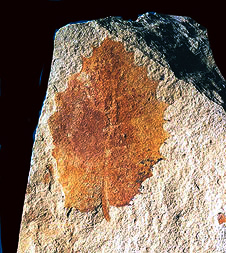 |
| Click on the images for larger pictures. Here are two essentially complete leaves from an evergreen live oak, called scientifically, Quercus pollardiana, a species that is identical in every major delineating leaf characteristic to the modern canyon live oak, Quercus chrysolepis (also called a maul oak), now native to the western slopes of the Sierra Nevada and the coastal ranges of California. The specimen at left is a nice example of a canyon live oak leaf with an entire, or smooth leaf margin; at right is a spinose leaf (it bears distinctive spines that project outward from the leaf margin) from the same oak species, Quercus pollardiana; canyon live oaks typically produce both kinds of leaves. The leaves of canyon live oak are among the most commonly encountered fossil plant specimens recovered from the Dead Camel Range near Fallon, Nevada. Both specimens are 30 millimeters in actual length. |
 |
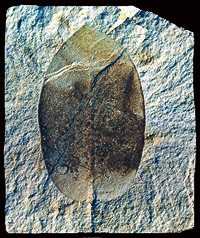 |
| Click on the images for larger pictures. At left is a winged flying seed (samara) from a species of spruce paleobotanists call Picea sonomensis; it appears to most closely resemble the flying seeds produced by the modern Brewer spruce, Picea breweriana, now native to the Klamath Mountains of northwestern California and southwestern Oregon; specimen is 12 millimeters long. At right is mostly complete leaf (the stem is missing) from the canyon live oak, Quercus pollardiana; specimen is 32 millimeters long. |
Gymnosperms Cupressaceae Juniperus nevadensis (utahensis) Utah Juniper Thuja dimorpha (plicata) Western Redcedar (a cypress) Pinacea Abies concoloroides (concolor) California White Fir Picea sonomensis (breweriana) Brewer Spruce Pinus florisanti (ponderosa) Ponderosa Pine Taxacea Torreya nancyana (californica) California-nutmeg Taxodiaceae Sequoiadendron chaneyi (giganteum) Giant Sequoia Angiosperms Berberidaceae Mahonia marginata (beali) Leatherleaf Mahonia Mahonia reticulata (repens) Oregon Grape Betulaceae Betula thor (papyrifera) Paper Birch Ericaceae Arbutus matthesii (menziessii) Pacific Madrone Fagaceae Quercus pollariana (chrysolepis) Canyon Live Oak Quercus simulata (myrsinaefolia) White Oak Quercus wislizenoides (wizlenii) Interior Live Oak Leguminosae Sophora spokanensis (japonica) Japanese scholartree Oleaceae Fraxinus alcornia (velutina) Arizona Ash Rosaceae Cercocarpus linearifolius (ledifolius) Curlleaf mountain-mahogany Salicaceae Populus eotremuloides (trichocarpa) Black Cottonwood Populus subwashoensis (tremula) European aspen Salix knowltoni (lemmonii) Lemmons willow Salix payettensis (exigua) Sandbar willow Typhaceae Typha lesquereuxi (latifolia) Common cattail |
| Hunter Mountain Beds | Coal Valley Formation | Chloropagus Formation | Pyramid Formation |

|